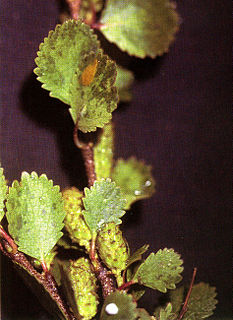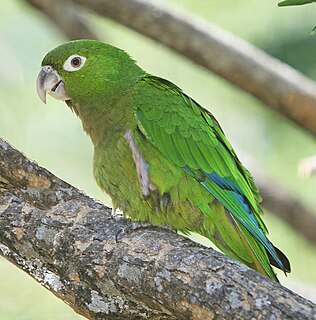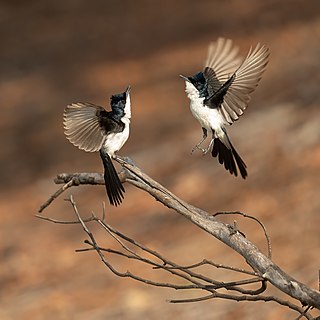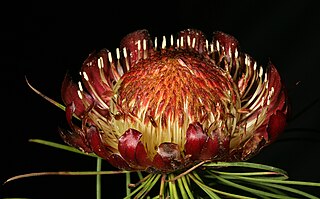
Dwarf tapeworm is a cosmopolitan species though most common in temperate zones, and is one of the most common cestodes infecting humans, especially children.

The pygmy brocket is a brocket deer species from South America. It is found in Argentina, southern Brazil and Paraguay. It is a small deer with short legs, weighing 15 to 20 kilograms. It is reddish-brown in color.

Betula nana, the dwarf birch, is a species of birch in the family Betulaceae, found mainly in the tundra of the Arctic region.
Nana, Na Na or NANA may refer to:

The dwarf wych elm cultivar Ulmus glabra 'Nana', a very slow growing shrub that with time forms a small tree, is of unknown origin. It was listed in the Simon-Louis 1869 catalogue as Ulmus montana nana. Henry (1913), referring his readers to an account of the Kew specimen in the journal Woods and Forests, 1884, suggested that it may have originated from a witch's broom. It is usually classified as a form of Ulmus glabra and is known widely as the 'Dwarf Wych Elm'. However, the ancestry of 'Nana' has been disputed in more recent years, Melville considering the specimen once grown at Kew to have been a cultivar of Ulmus × hollandica.

Banksia nana, commonly known as dwarf dryandra, is a species of shrub that is endemic to a small area in the south-west of Western Australia. It has underground stems, pinnatipartite leaves with sharply-pointed lobes, pale green or yellow flowers and broadly egg-shaped follicles.

The banana pipistrelle is a species of vesper bat found throughout much of Africa. It was previously known as Pipistrellus nanus, but genetic analysis has since shown it to be more closely related to other species in the genus Neoromicia.
Ptychadena nana is a species of frog in the family Ptychadenidae. It is endemic to Ethiopia. It is only known with certainty from its type locality, Arussi Mountains, in the Ethiopian Highlands; these mountains are also referred to as the Arsi Mountains. There is uncertainty regarding reports from elsewhere, which perhaps refer to other, possibly undescribed species. Freilich and colleagues found specimens from the Bale Mountains to be larger than "normal" Ptychadena nana, but that molecular data clustered them with other P. nana. Common names Somali grassland frog and smallest grass frog have been coined for it.

The olive-throated parakeet, also known as the olive-throated conure in aviculture, is a species of parrot in the family Psittacidae. It is found in forest and woodland in Jamaica, Mexico and Central America, and has been introduced to the Dominican Republic.

The Somali dwarf shrew is a species of mammal in the family Soricidae. It is found in Ethiopia and Somalia. Its natural habitat is subtropical or tropical dry lowland grassland.

The Cuban fruit-eating bat is a species of bat in the family Phyllostomidae found in the Cayman Islands, Cuba, and Hispaniola .It has been extirpated from the Bahamas and Jamaica.

The lesser yellow-shouldered bat is a species of bat in the family Phyllostomidae. It is native to Peru and Ecuador. It is threatened by habitat loss.
Microstrophia modesta is a species of air-breathing land snail, terrestrial pulmonate gastropod mollusc in the family Streptaxidae.
Microstrophia is a genus of air-breathing land snails, terrestrial pulmonate gastropod mollusks in the family Streptaxidae.
Dryandra ser. Niveae is an obsolete series within the former genus Dryandra. It was first published by George Bentham in 1870, and was given a new circumscription by Alex George in 1996, but was ultimately discarded in 2007 when Austin Mast and Kevin Thiele sunk Dryandra into Banksia.

The paperbark flycatcher, also known as the little restless flycatcher, is a passerine bird in the family Monarchidae. It occurs in tropical woodland and riverine habitats of northern Australia and southern New Guinea. Previously, some authorities lumped the paperbark flycatcher as a distinctive subspecies of the restless flycatcher of southern and eastern Australia, with which it forms a superspecies.

Protea pityphylla, also known as Ceres sugarbush or mountain rose, is a flowering shrub of the genus Protea, in the family Proteaceae. The plant is endemic to the southwestern Cape Region of South Africa.

Protea nana, also known as the mountain rose or mountain-rose sugarbush, is a flowering shrub which belongs within the genus Protea.












